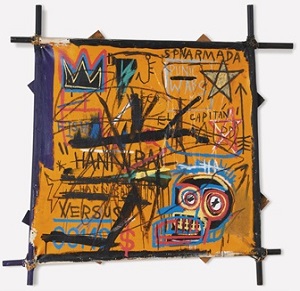Hannibal (Basquiat)
Hannibal is a notable painting by the influential American artist Jean-Michel Basquiat. Created in 1982, this work is part of Basquiat's extensive portfolio that explores themes of identity, socio-political issues, and African-American heritage. Basquiat's unique style combines elements of graffiti, neo-expressionism, and primitivism, making his work stand out in the contemporary art scene of the 1980s.
Description[edit | edit source]
Hannibal is characterized by its vibrant colors, chaotic brushstrokes, and the integration of words and symbols. The painting features a central figure, possibly representing Hannibal Barca, the famed Carthaginian general, though Basquiat's depiction abstracts and distorts historical accuracy in favor of emotional expression and thematic exploration. Surrounding the figure are various cryptic symbols and text, a hallmark of Basquiat's style, which invites viewers to decipher its meaning.
Themes[edit | edit source]
The painting delves into themes of power, history, and race. By choosing Hannibal, a historical figure who challenged the Roman Empire, Basquiat reflects on the struggle against dominant narratives and powers. The work can be seen as a commentary on the artist's own battles with the predominantly white art world and his efforts to reclaim African-American history and identity through his art.
Technique and Style[edit | edit source]
Basquiat's technique in Hannibal is emblematic of his broader work, characterized by a fusion of drawing and painting, with a spontaneous, almost childlike application of paint. His use of symbols, words, and figures draws from a diverse range of influences, including art history, music, and pop culture, as well as his personal experiences in New York City's Lower East Side.
Legacy[edit | edit source]
Since its creation, Hannibal has been celebrated for its complex interplay of history, culture, and identity. Basquiat's work has had a profound impact on the art world, challenging traditional boundaries and inspiring a new generation of artists. Hannibal, like much of his oeuvre, remains a powerful testament to Basquiat's genius and his enduring relevance in discussions of race, art, and society.
Exhibitions and Collections[edit | edit source]
Hannibal has been exhibited in numerous galleries and museums around the world, reflecting Basquiat's international acclaim. The painting is often highlighted in retrospectives of Basquiat's work, showcasing its significance within his body of work.
Search WikiMD
Ad.Tired of being Overweight? Try W8MD's physician weight loss program.
Semaglutide (Ozempic / Wegovy and Tirzepatide (Mounjaro / Zepbound) available.
Advertise on WikiMD
|
WikiMD's Wellness Encyclopedia |
| Let Food Be Thy Medicine Medicine Thy Food - Hippocrates |
Translate this page: - East Asian
中文,
日本,
한국어,
South Asian
हिन्दी,
தமிழ்,
తెలుగు,
Urdu,
ಕನ್ನಡ,
Southeast Asian
Indonesian,
Vietnamese,
Thai,
မြန်မာဘာသာ,
বাংলা
European
español,
Deutsch,
français,
Greek,
português do Brasil,
polski,
română,
русский,
Nederlands,
norsk,
svenska,
suomi,
Italian
Middle Eastern & African
عربى,
Turkish,
Persian,
Hebrew,
Afrikaans,
isiZulu,
Kiswahili,
Other
Bulgarian,
Hungarian,
Czech,
Swedish,
മലയാളം,
मराठी,
ਪੰਜਾਬੀ,
ગુજરાતી,
Portuguese,
Ukrainian
Medical Disclaimer: WikiMD is not a substitute for professional medical advice. The information on WikiMD is provided as an information resource only, may be incorrect, outdated or misleading, and is not to be used or relied on for any diagnostic or treatment purposes. Please consult your health care provider before making any healthcare decisions or for guidance about a specific medical condition. WikiMD expressly disclaims responsibility, and shall have no liability, for any damages, loss, injury, or liability whatsoever suffered as a result of your reliance on the information contained in this site. By visiting this site you agree to the foregoing terms and conditions, which may from time to time be changed or supplemented by WikiMD. If you do not agree to the foregoing terms and conditions, you should not enter or use this site. See full disclaimer.
Credits:Most images are courtesy of Wikimedia commons, and templates Wikipedia, licensed under CC BY SA or similar.
Contributors: Prab R. Tumpati, MD

